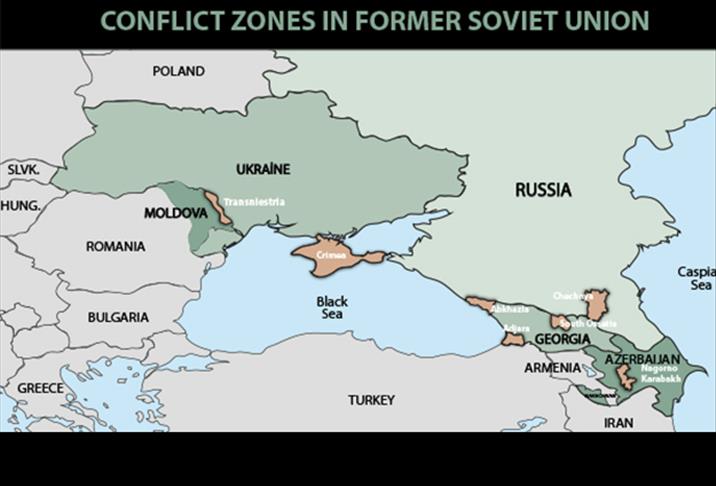
By Nicholas A. Waller
TIRASPOL, Moldova
Crossing the border from Ukraine into Moldova’s breakaway Transnistria region is a window into the absurdly murky world of post-Soviet frozen conflict zones.
Ukrainian border guards heavily scrutinize passports and wonder -- often in amazement -- why anyone would want to cross into a region considered to be Eastern Europe’s most forbidding and lawless.
Situated on a narrow strip of land straddling the banks of the Dniester River, sandwiched between Ukraine and Moldova, Transnistria has for over two decades functioned as an internationally unrecognized, Moscow-backed, pseudo-Soviet state dominated by former KGB and GRU (Soviet military intelligence) officers-turned businessmen who are propped up by a vast internal security apparatus.
Since winning its self-declared independence in 1992, Transnistria has gained a reputation as a global center for illegal arms production, human trafficking and a paranoia towards the outside world that would make Enver Hoxha’s communist Albania proud.
- Moscow-backed independence
Like fellow breakaway states Abkhazia, South Ossetia, Nagorno-Karabakh and now Crimea, Transnistria gained its post-Soviet independence with the help of the Kremlin.
As the Soviet Union entered into its twilight years, Moscow-backed separatists declared independence from the Moldovan Soviet Socialist Republic in 1990 after the republic’s government declared Romanian the official language.
Incensed by Chisinau’s move towards unification with Romania following the Soviet Union’s collapse, Russia provided a military and economic lifeline to the region in an attempt to wield influence on either side of the Ukrainian border.
War broke out between Transnistria’s separatists and newly independent Moldova in March 1992. After months of heavy fighting in and around the breakaway region’s capital Tiraspol, separatist forces -- with the help of Russia’s 14th Army and Don Cossack volunteers -- routed Moldova’s ill-equipped military.
As the main arbiter in the ensuing cease-fire, Russia stationed 2,000 peacekeepers in the region to protect the 14th Army’s massive arms depot in Transnistria’s northern Kolbasa region.
The area was and remains a heavily guarded closed district.
- Window into the Soviet past
Tiraspol is a ramshackle collection of crumbling Brezhnev-era apartment blocks and old stone buildings, interspersed with Soviet monuments and small parks -- all hallmarks of cities in the Soviet Union that give them the air of a giant university campus.
Red banners, hammer and sickle emblems and statues of Lenin continue to adorn countless buildings. The local government is still known as the Supreme Soviet and the omnipresent security service continues to go by the name of KGB.
The city lives up to its reputation as a window to the late 1980s, a time when the gloss had come off Soviet President Mikhail Gorbachev’s campaign of 'perestroika' and 'glasnost.'
- Shadowy business, foreign subsidies
Transnistria has been able to remain afloat due to the huge subsidies provided by Moscow and the profits its shadowy business class makes from illicit arms deals and the smuggling of women and counterfeit consumer products to other parts of Europe.
The region allegedly has tens of thousands of tons of Soviet-made conventional munitions stored in various clandestine facilities. More troubling, however, was the 2011 arrest of two Transnistrian arms dealers who attempted to sell several tons of enriched uranium to Moldovan undercover police officers.
Russia has propped up corrupt local officials with a gas-purchasing scheme that has Russian companies buy gas for Transnistria, which is then given to local businessmen to be sold at the region’s sole petrol station chain, Sheriff.
Run by a cadre of former Soviet security officers, Sheriff -- the name derives from the shareholders’ previous employment as guardians of the state -- is a vast business empire that includes the largest supermarket chain, a luxury car dealership, the region’s main TV channel, petrol stations, a brandy distillery, advertising agencies, vineyards, hotels, publishing houses, a telecommunications network as well as FC Sheriff and its US$200 million state-of-the-art stadium.
Despite this, the renegade state continues to insist on its legitimacy.
The government -- despite international condemnation -- has issued 'Transnistrian' passports to its 500,000 residents, set up a 25,000-man military and printed its own money.
- Paranoia and the hospitality industry
"Taxi. Taxi…where do you want to go friend? Hey brother, where to?"
"Timoty Hotel."
The exasperated look on every taxi driver’s eyes when hearing a foreign accent is the first indication that outsiders are neither a common sight nor terribly welcome.
Foreigners -- as the KGB border guards like to explain -- are 'encouraged' to leave the region within 72 hours or risk facing a private hearing with the local security services.
Visitors are also warned -- without further details -- to refrain from taking 'unnecessary photos.'
Every foreigner ends up staying at the same Soviet Intourist-type hotel where, by a great coincidence, the very gracious and bleached haired hostess speaks excellent English -- a rarity in Transnistria.
Even more astonishing is her knowledge of your arrival prior to any advanced booking or phone call.
Once outside, Tiraspol’s grid patterned, half-empty streets give no indication that the city is the capital of a self-styled sovereign state. The colorless apartment blocks and dilapidated stone houses reveal the bleak existence of day-to-day life in the city.
Nearly every building, including those belonging to the city administration, is on the verge of collapse.
The only areas that have received proper care over the years are the numerous World War II memorials and Lenin statues.
If a passerby lingers too long to admire the republic’s 1960s parliament building, gazing at the massive red marble statue of Lenin or talk on their mobile phone, local security officials are quick to confiscate any item they deem a threat to state security.
- Peacekeepers, tank traps, 'nothing to see'
A short drive from Tiraspol, on the western bank of the Dniester, the city of Bendery saw the heaviest fighting during the 1992 war.
It now houses the largest contingent of Russian peacekeepers, one of the region's purported weapons manufacturing plants and huge fields used for tank training exercises -- the same facilities the Russian army used last week that alarmed many Western analysts.
"What is that in front of us?
"Nothing to see. Former Russian military base. Now Sheriff owns the land."
"Why does the command building have a Russian flag flying over it if it is a former base? Why are new barracks being built?”
“Nothing to see,” the taxi driver, Alexander, said.
Moments later when passing a vast industrial production complex with 50 meter-high concrete enforced storage silos, Alexander -- who carried a holstered pistol inside his leather jacket, repeated the same answer.
“Nothing to see. They're used to store grain."
"Is that a new practice…storing grain in reinforced concrete?"
"Time to go back to Tiraspol. Look, very beautiful," the impatient Alexander said while attempting to divert attention by pointing to a riverside Ottoman-built castle-turned-military-base that he proudly proclaimed, "Baron Von Munchhausen rode the cannonball there."
Once on the eastern side of the river, the area's grassy steppes have been turned into a massive tank training facility. Trenches, tank traps, hundreds of obstacles, radar stations, missile batteries and the wrecked storage facilities of the 14th Army’s mechanized units extend far into the horizon.
"How many Russian troops are here?"
"1,000…maybe 1,200. They all left," Alexander said with a sigh.
"When?"
"How should I know? A long time ago."
"Will they come back? Will Transnistria join Russia?"
With a wry smile, "We'll see. We'll wait and see."
englishnews@aa.com.tr


